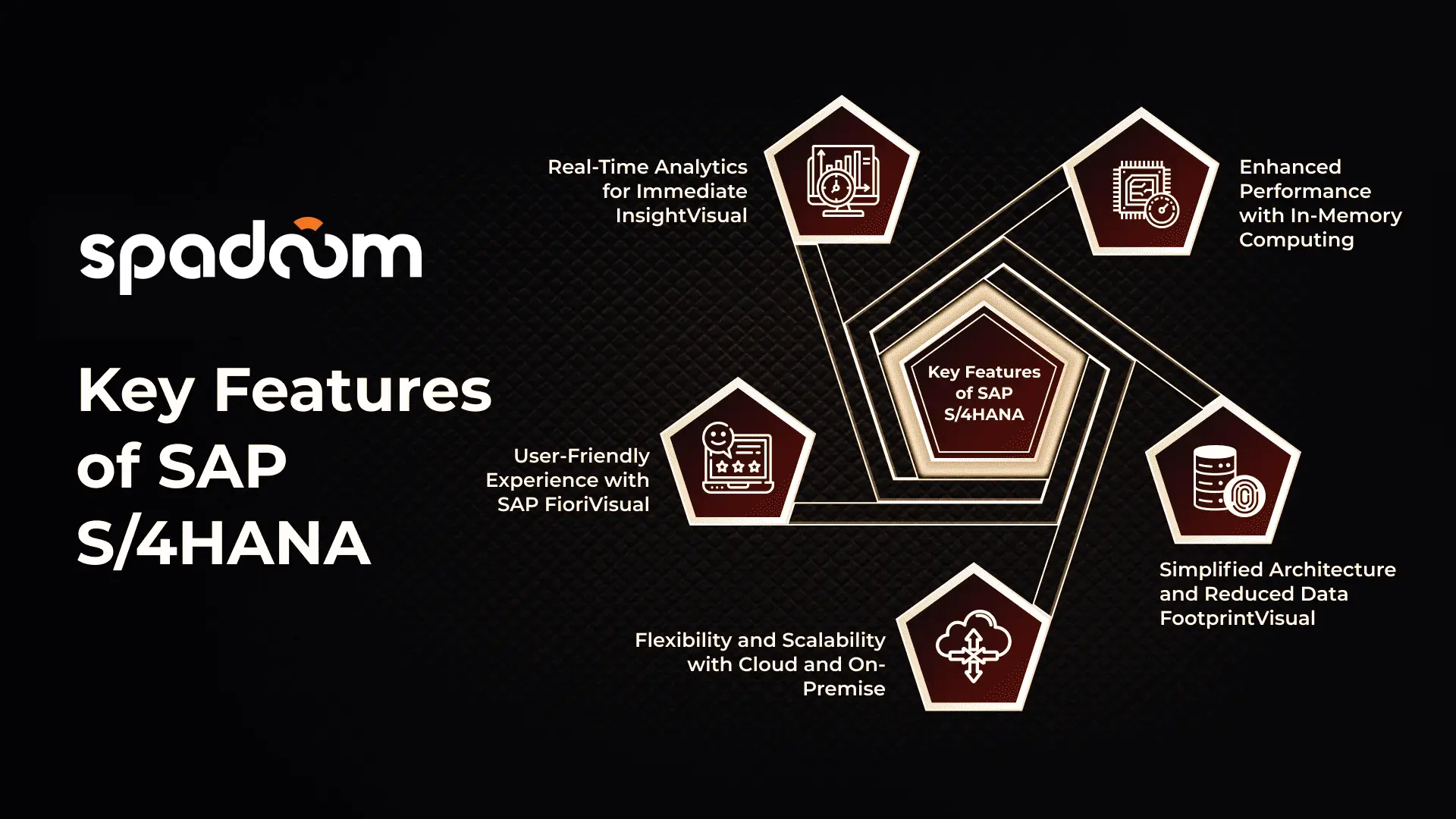Key Features of SAP S/4HANA: Simplifying Business with Intelligence
As technology and work are quickly becoming unseparated in today’s raced business world, businesses need software that both keeps up with their rhythm as well — or even helps them to jump ahead. Having said that, you will get to know the next generation ERP System i.e., SAP S/4HANA. It is a unified platform which aligns with organizations in terms of simplifying, integrating and providing insights into operations. Here, we look at the top benefits of SAP S4HANA and how these translate to real business value.
1. In-Memory Database for Real-Time Processing
The in-memory computing engine at the core of SAP S/4HANA is SAP HANA. Rather than being a conventional disk-based relational database system, SAP HANA is an in-memory system. This enables enterprises to quickly handle important information by offering real-time analytics and data processing at the speed of light.
Imagine yourself as a supply chain manager who is attempting to locate one of these bottlenecks. SAP S/4HANA processes it in real-time, allowing you to easily generate those reports as needed within seconds and investigate the issue immediately so decisions can be made quickly that save time and money accordingly.
2. Simplified Data Model
The simple data model is one of the key features of SAP S/4HANA. Legacy ERPs may have been designed 30+ years ago, often relying on unique and redundant tables that made the system hard to maintain and analyze. These complexities are eliminated by SAP S/4HANA, which reduces data redundancy and uses streamlined structures. This results in rapid reporting, fewer errors, and improved data analysis capabilities.
It’s like cleaning up your workspace—when everything is streamlined, it’s easier to access what you need quickly and achieve greater productivity. It also generates fewer tables to maintain, making your system more efficient and easier to manage.
3. Fiori User Experience (UX)
The SAP Fiori user interface, included with SAP S/4HANA, changes the way users engage with the system. SAP Fiori’s user-centric design provides a customized, intuitive interface. The desktop, tablet, and smartphone experiences are all the same and accessible on all platforms.
Consider the following scenario: you are a field service technician using a mobile device to access SAP S/4HANA.Without having to go through complicated menus, you can track work orders, view customer information, and update statuses quickly and easily thanks to the straightforward and intuitive UI. To make the system more accessible to all employees, whether they are at a desk or on the go, it is designed to save training time and guarantee users in various jobs can use it with ease.
4. Embedded Analytics and Intelligent Insights
Access to data is no longer sufficient in the digital era; you also need meaningful insights. Analytics are incorporated within SAP S/4HANA’s basic functions, eliminating the need for separate systems and providing users with embedded analytics. In finance, human resources, logistics, instantaneous analytics are at your fingertips.
For instance, consider you to be a financial analyst tracking the performance of the company. Embedded Analytics allows you to dig down into your reports and drill past financial figures, where it can deliver immediate insight on transactions or trends as well. This ensures you can take data-backed decisions readily to enhance the business. In addition, SAP S/4HANA, supported by AI and machine learning, allows predictive intelligence with automation. For example, in the procurement industry, the system has access to historical data and can use Machine Learning to predict demand so that organizations can optimize inventory levels and avoid both stockouts as well as over-ordering.
5. Integrated Business Processes
The ability of SAP S/4HANA to combine all essential business processes—from supply chain and procurement to finance and sales—onto a single platform is among its most potent characteristics. This eliminates departmental silos and promotes collaboration, ensuring that information flows freely throughout the organization.
Consider a situation in which a customer places an order. Thanks to SAP S/4HANA, the finance team can process the invoice immediately, the sales team can examine the inventory that is available in real-time, and the warehouse team can ensure that the product is delivered on time—all without any delays or missed information. This connection increases overall efficiency and improves customer satisfaction by guaranteeing departmental alignment.
6.Cloud, On-Premises, and Hybrid Deployment Options
With the flexibility of SAP S/4HANA’s deployment types, enterprises can opt for on-premises, cloud, or hybrid solutions. Companies can use the system in accordance with their requirements, financial constraints, and long-term scalability goals, thanks to its flexibility.
To cut infrastructure expenses and IT upkeep, small and medium-sized businesses (SMBs) may choose cloud deployment. However, to have more control over their data, larger enterprises with intricate security requirements can choose to use an on-premises solution.
7. Advanced Financial Management
SAP S/4HANA has a few features like tools for better insight and automated analysis in which it excels. Enter Works finance supports processes such as accounts payable, accounts receivable, and treasury management in business operations. The system allows for continuous accounting, or keeping financials updating in real-time, which means planners can kiss month-end and year-end closes goodbye. Visualize the ability to close your books as transactions are occurring instead of getting a one-time monthly reconciliation. Faster reporting. More accurate forecasts. Better decisions.
8. Centralized Master Data Management
Any ERP system’s foundation is its master data, and SAP S/4HANA makes sure that companies have a unified, consistent view of their master data. This function increases the correctness of business processes, guarantees data consistency, and lessens duplication.
Duplication and inconsistency are particularly likely when managing client data across several systems. By ensuring that everyone in the company has access to the same exact data, SAP S/4HANA’s unified master data management helps to cut down on errors and enhance decision-making.
9. Enhanced Supply Chain Management
Today, business runs on the efficiency of the supply chain and SAP S/4HANA has some amazing tooling that allows you to manage your supply chain more effectively. The visibility of the whole supply chain, from suppliers to customers, is end-to-end for better process in demand forecasting, inventory management and procurement. For instance, by adopting real-time inventory tracking businesses can steer clear of situations where they are overstocked or out-of-stock and this reduces carrying costs while also making sure the deliveries happen on time thus enhancing customer satisfaction.
10. Industry-Specific Solutions
With flexibility in mind, SAP S/4HANA provides industry-specific solutions that may be customized to satisfy specific needs. Retail, manufacturing, healthcare, and finance are just a few of the industries for which SAP S/4HANA may be tailored to meet unique needs.
As an illustration, the system’s real-time production planning and scheduling features guarantee the smooth and effective running of production lines in the industrial sector.
Conclusion
Simply put, it is more than just an ERP system; SAP S/4HANA provides a platform that aims to fundamentally change how companies function in the digital world. Regardless of your size—a tiny startup or a large corporation—SAP S/4HANA grows with you and adjusts to your demands. It is not simply a system, however an important partner in reaching your firm’s goals.






